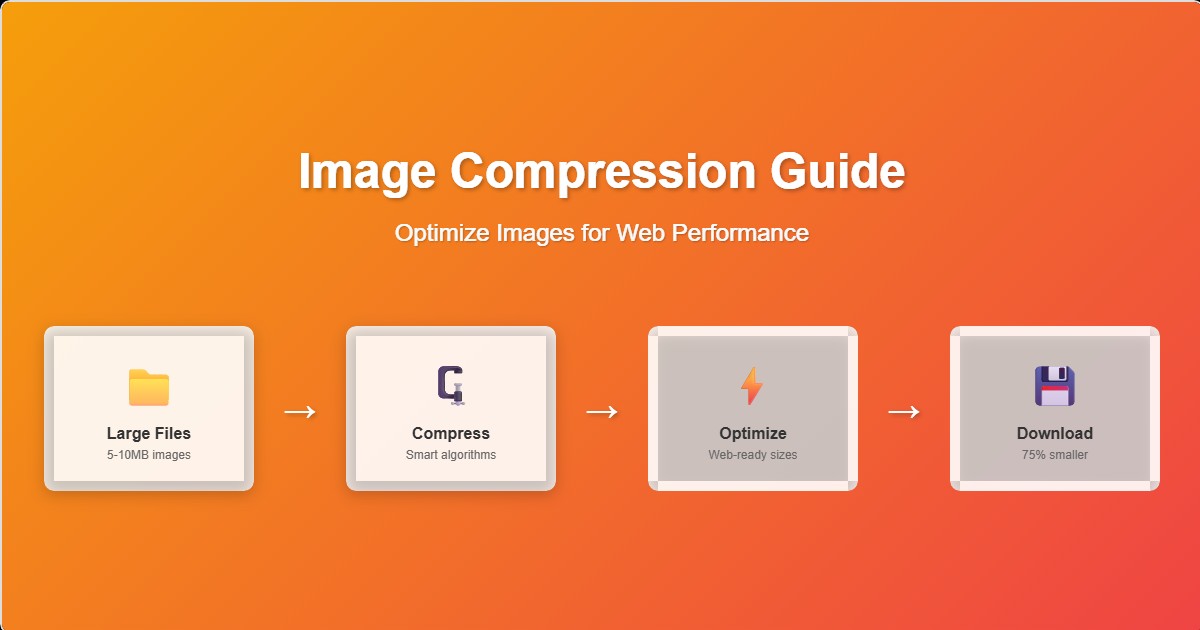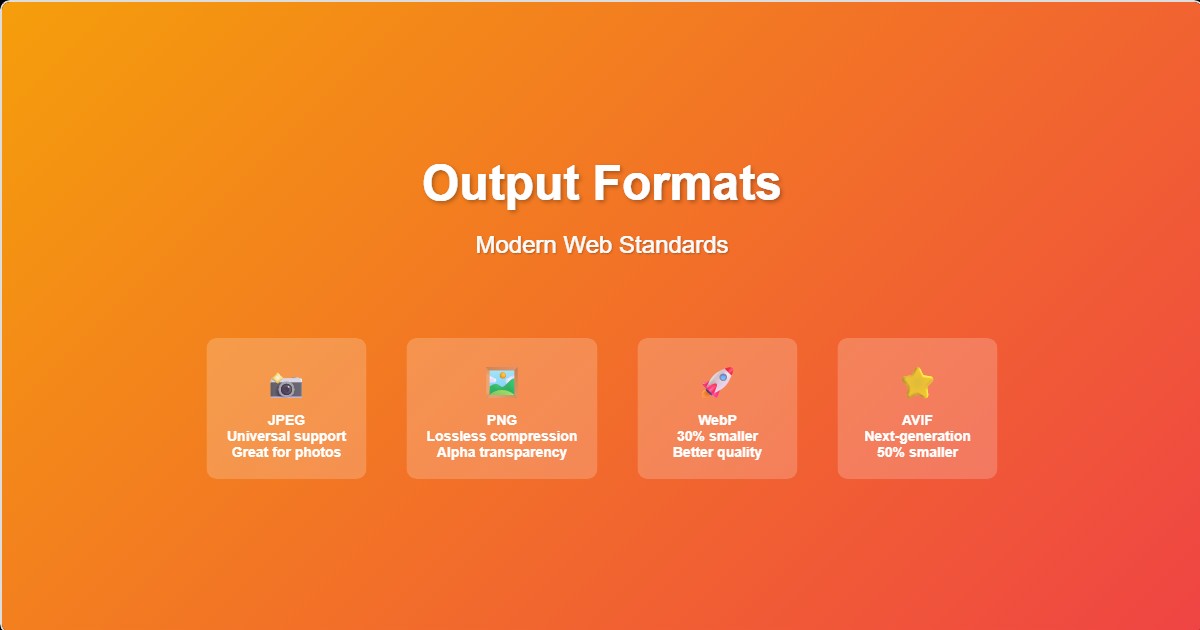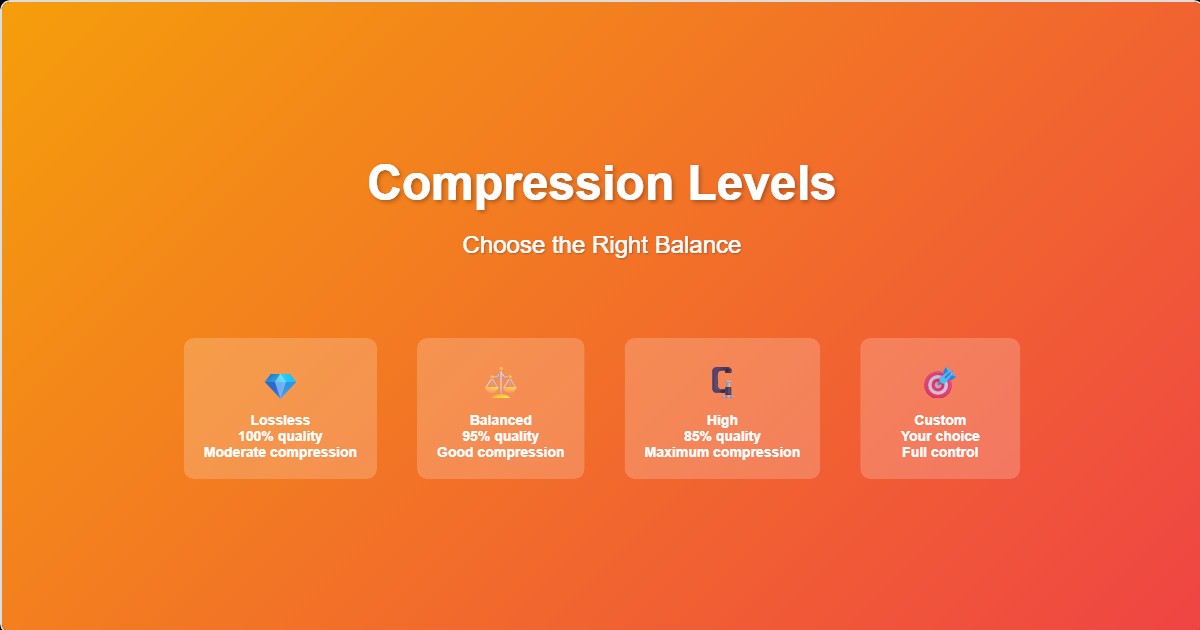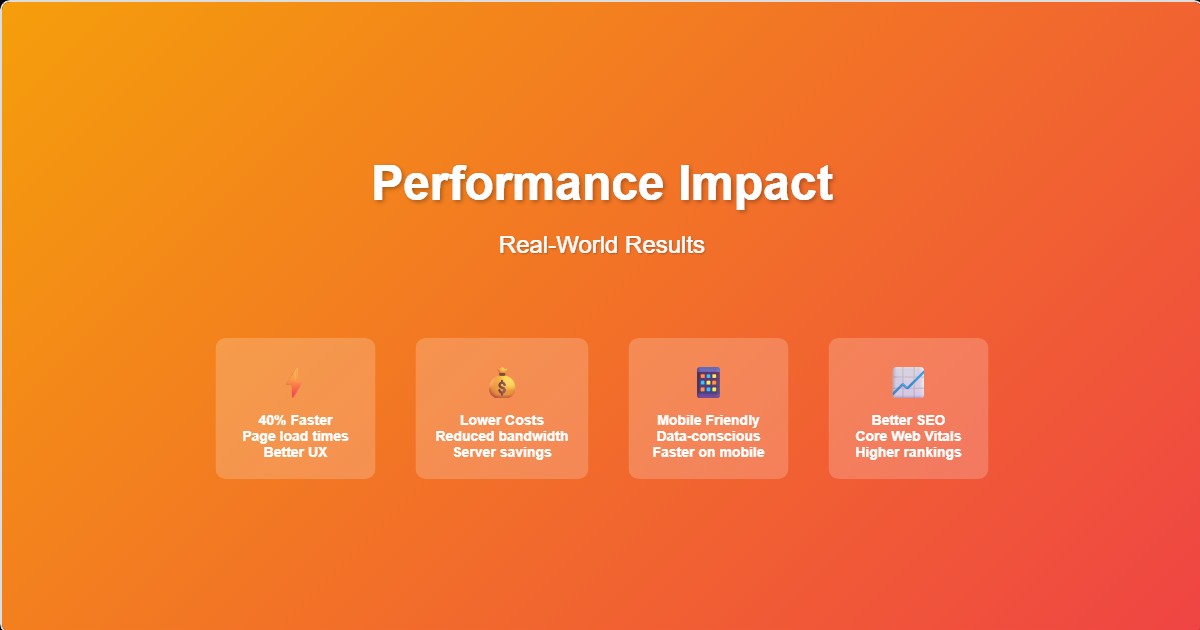How to compress images for web performance?
Master the art of image compression to boost your website's speed and user experience

Quick Facts
- • Images account for 65% of total web page weight
- • 47% of users expect pages to load in 2 seconds or less
- • WebP format reduces file size by 25-50% vs JPEG
- • 1-second delay decreases conversions by 7%
- • Proper compression can reduce load times by 70%
Understanding Image Compression
Image compression is the process of reducing image file size while maintaining acceptable visual quality. There are two main types of compression: lossy and lossless. Understanding when to use each type is crucial for web performance optimization.
Lossy vs Lossless Compression
Lossy Compression
- • Reduces file size by removing image data
- • JPEG, WebP, AVIF formats
- • Best for photos and complex images
- • Quality adjustable from 0-100%
- • Typical web quality: 80-90%
Lossless Compression
- • Preserves all original image data
- • PNG, GIF, WebP lossless formats
- • Best for logos and simple graphics
- • Perfect quality reproduction
- • Larger file sizes than lossy
Modern Image Formats
Modern image formats offer significantly better compression than traditional formats. Here's a comparison of the most important formats for web use:

| Format | Compression | Browser Support | Best Use Case |
|---|---|---|---|
| JPEG | Good (baseline) | Universal (100%) | Photos, complex images |
| PNG | Moderate (lossless) | Universal (100%) | Logos, transparency |
| WebP | Excellent (25-50% smaller) | Modern browsers (95%) | All image types |
| AVIF | Best (50% smaller) | Limited (80%) | Modern web apps |
Quality Settings Guide
Choosing the right quality setting is crucial for balancing file size and visual quality. Here's a comprehensive guide for different use cases:

Quality 95-100% (Highest)
Use for: Hero images, product photography, print-quality images
Quality 80-90% (Recommended)
Use for: Most web images, blog photos, general content
Quality 60-75% (Balanced)
Use for: Thumbnails, gallery images, mobile optimization
Quality 30-60% (Aggressive)
Use for: Placeholder images, low-bandwidth scenarios
Content-Aware Compression
Different types of images require different compression approaches. Understanding content-aware compression helps you achieve optimal results for each image type.
Photographs
- • Use JPEG or WebP lossy compression
- • Quality 80-90% for web display
- • Enable progressive encoding
- • Consider chroma subsampling
- • Remove EXIF data for privacy
Graphics & Logos
- • Use PNG for transparency needs
- • Use SVG for scalable graphics
- • WebP lossless for modern browsers
- • Optimize color palette
- • Consider vector alternatives
Screenshots
- • PNG for text-heavy screenshots
- • JPEG for photo-like screenshots
- • Higher quality for readability
- • Crop unnecessary areas
- • Use appropriate dimensions
Icons & Illustrations
- • SVG for scalable icons
- • PNG for complex illustrations
- • WebP for modern browsers
- • Optimize for retina displays
- • Use icon fonts when appropriate
Batch Processing Workflow
For efficient image compression at scale, establish a systematic workflow that handles multiple images consistently and efficiently.
Professional Workflow Steps
Image Audit
Analyze current images, identify large files, catalog formats
Quality Standards
Define quality thresholds, establish naming conventions
Batch Processing
Process multiple formats, automate quality settings
Quality Assurance
Verify output quality, check file sizes, test loading
Deployment
Replace original files, update references, monitor performance
Advanced Compression Techniques
Beyond basic compression, advanced techniques can further optimize image delivery and performance.
Progressive JPEG
Progressive JPEGs load in multiple passes, showing a low-quality version first that gradually improves. This provides better perceived performance.
Responsive Images
Serve different image sizes based on device capabilities and viewport size to optimize bandwidth usage.
Lazy Loading
Load images only when they're about to enter the viewport, reducing initial page load time and bandwidth usage.
CDN Optimization
Use Content Delivery Networks with automatic image optimization features to serve optimized images based on user conditions.
Performance Monitoring
Regularly monitor your image performance to ensure your compression strategy is effective and identify areas for improvement.
Key Metrics to Track
Page Load Time
Total time to load all images
First Contentful Paint
Time to first image render
Cumulative Layout Shift
Layout stability during loading
Bandwidth Usage
Total data transferred
Image Format Adoption
Modern format usage rates
Quality Scores
Lighthouse performance metrics
Common Compression Mistakes
Avoid these common pitfalls that can hurt your image optimization efforts and overall website performance.
❌ Over-compression
Setting quality too low results in visible artifacts and poor user experience. Always test quality settings visually across different devices.
❌ Wrong format choice
Using JPEG for graphics with text or PNG for photographs. Match the format to the content type for optimal compression.
❌ Ignoring modern formats
Sticking to JPEG/PNG only. Modern formats like WebP and AVIF offer significant size reductions with better quality.
❌ No responsive strategy
Serving high-resolution images to all devices. Use responsive images and appropriate sizing for different screen sizes.
Industry Best Practices
Learn from industry leaders and implement proven strategies for optimal image compression results.
E-commerce Sites
- • Multiple image sizes for product views
- • Progressive loading for galleries
- • High-quality hero images (90%+ quality)
- • Thumbnail optimization for browsing
- • Zoom functionality considerations
News & Media
- • Fast-loading thumbnail grids
- • Progressive JPEG for articles
- • Aggressive compression for mobile
- • Lazy loading for infinite scroll
- • CDN optimization for global reach
Portfolio Sites
- • High-quality showcase images
- • Watermark protection strategies
- • Fast preview generation
- • Responsive gallery layouts
- • Download protection measures
Social Media
- • Platform-specific optimizations
- • Real-time image processing
- • User-generated content handling
- • Multiple format support
- • Bandwidth-aware delivery
Performance Impact Statistics

Tools and Resources
Essential tools and resources for implementing and maintaining an effective image compression strategy.
Online Tools
- • TinyPNG/TinyJPG
- • Squoosh (Google)
- • ImageOptim
- • Kraken.io
- • Compressor.io
Desktop Software
- • Adobe Photoshop
- • GIMP (free)
- • ImageOptim (Mac)
- • FileOptimizer (Windows)
- • XnConvert (batch)
Developer Tools
- • webpack image loaders
- • Sharp (Node.js)
- • Pillow (Python)
- • ImageMagick
- • Lighthouse audits
Ready to Optimize Your Images?
Start compressing your images today with our free batch image compressor tool. Process multiple images simultaneously with professional-grade compression algorithms.